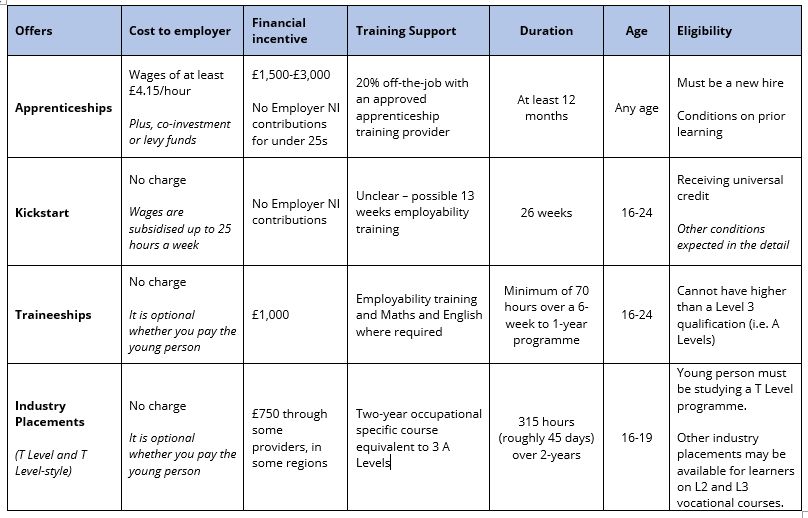
On Thursday, the Chancellor of the Exchequer, Rishi Sunak, announced several incentives to encourage employers to create more work opportunities for young people over the next six months, rather than batten down the hatches to weather the post-lockdown storm.
Yet, at first glance, it’s all a bit confusing… Some of the schemes seem to compete with one another and it’s unclear who will be eligible for what. Of course, the devil will be in the detail of the schemes’ rules, but as these incentives aren’t available for long, it’s important to start to decipher how you will articulate these opportunities to employers.
So, to help you on your way – we’ve asked SDN’s Partnership Manager, Phil Golding, to look at four of the schemes that have employer incentives, outline some of the pros and cons for each, and explain how you might engage employers through a socially responsible message…
Explaining Apprenticeships, Kickstart, Traineeships and Industry Placements
This table gives a quick snapshot of the options available to employers. If you want the current detail, read A Plan for Jobs 2020 policy document where the schemes are explained more comprehensively.

Firstly, it’s really important that training providers can explain the differences in these schemes to employers. It will take time for the government to reach out to businesses and ramp up their communications, which means training providers are in an important position to offer impartial workforce development advice to employers now, to help them recover from lockdown and prepare for the future.
You can use the table as part of an organisational needs analysis, to give employers clarity of their options, but you will need to go into more detail to really delve into what would work best in their current situation. See examples below…
Apprenticeship
As you can see from the table, apprenticeships are the only scheme where there is a charge to the employer – and it is significant. Yes, they could get £3,000 towards the costs, but they still have to pay wages and co-investment/levy payments.
This means apprenticeships are almost business as usual. If an employer is confident of their business’s long-term survival – the message is the same – apprenticeships can help them develop a skilled workforce over the long-term. The financial incentive (alongside the reservation cap for non-levy employers being increased from 3-10 apprentices) is really the carrot to get things moving as soon as possible.
If the employer isn’t able to commit to 12 months or more of training now, that’s understandable, but you can work with them at a later date, to progress suitable young people from the other schemes onto apprenticeships as they near the end.
Kickstart
The Kickstart scheme could be a good opportunity for employers that are uncertain about their business’s future, to get staff in to support their workload without any financial contribution.
What’s more, the young person gets paid more than they would receiving the standard allowance on universal credit. This is likely to encourage many young people to get involved, take an opportunity and contribute to a business’s success.
However, at time of writing, the eligibility and design of the Kickstart scheme is unclear. Employers may not get a chance to interview or choose candidates, which could be off putting for some businesses, and it has also been suggested that there will be 13 weeks of job-ready training before employment starts – which implies it could be a while before employers can access this support at all.
Traineeships
Traineeships are another finance free option for employers, and unlike Kickstart, the employer receives £1,000 for the placement (up to 10 trainees).
However, this is different to the Kickstart. The young person isn’t being paid, so for a young person choosing between the schemes, this could be off-putting and could make it hard to encourage a young person to grasp the opportunity with both hands.
This is why it’s so important to talk through the opportunity with the employer at the start, and ideally talk about financial contributions for the young person and/or progression opportunities (into work or an apprenticeship).
It has also been suggested that the government will increase the number of providers able to deliver traineeships so that employers and young people, wherever they are based in the country, will have more opportunity to access these programmes.
SDN ran a traineeship webinar to support providers understand traineeships in more detail and identify what a procurement process might involve. To watch the recording for FREE, click here.
Industry placements
Although not given the same profile in the Chancellor’s speech, T Levels start in September in Construction, Digital, Education and Childcare and employers can offer an industry placement to students in roles that relate to their specific course.
These placements are designed around thorough 2-year Level 3 study, which will appeal to some employers keen to get in young people with a good grounding in a subject. There is also financial support of £750 to cover supervision costs, equipment and uniform offered by some providers, in some regions, so suggest this route to employers as part of their options too.
Further details on industry placements can be found at the Employer Industry Placements website that SDN delivers on behalf of the Department for Education.
With employers clearer on each scheme, how can you reach out to business at this time?
Whilst it is important that training providers should talk to employers about the business impact their training and support service has, the new schemes and incentives launched by the government do also provide an opportunity to reach out to employers who aren’t necessarily looking to recruit long-term – to provide a ‘socially responsible’ opportunity to a young person.
Everyone knows someone that has been furloughed, is facing redundancy or out of work. These schemes can give a young person the chance they need to gain new skills that could set them up over the long-term, even if that employer is unlikely to offer a job at the end.
Offering a traineeship, for example, with no financial contribution to the business, plus a £1,000 payment to cover supervision costs could be enough of an incentive for an employer to give someone a taste of work and a chance to learn a role, when they might not otherwise have done so.
Engaging businesses that are looking to develop the workforce long-term and businesses that want to ‘give something back’ by offering meaningful opportunities are both worth pursuing at this time.
What next?
It is expected that further details of traineeship procurement will be released in due course. SDN will be offering targeted traineeship support to providers when the detail of the procurement exercise has been released. Sign up to our mailing list to receive an update on this support when details have been confirmed. https://www.strategicdevelopmentnetwork.co.uk/contact-us/
